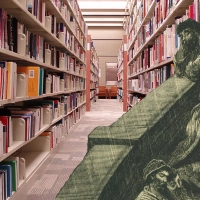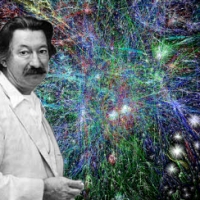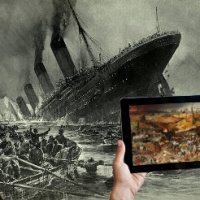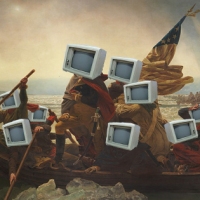Will Technological Critique Emerge with Emerging Technology Librarians?
Despite what seems to be a constant chorus foretelling their doom, libraries hold steady. This is not to say that libraries are not shaken by the storms of technological change and economic downturns, but like a well made book, libraries stay strong throughout the ages. Though librarians may sometimes be unfairly tarred with the epithet (and in such cases it is always used as an insult) of “Luddite,” the truth is that libraries genuinely try to shift and evolve with the technological times – and their tech adoption may be slowed more by financial constraints than technophobia. Librarians may be tenacious in their clinging to books, but they cling even more firmly to the notion that libraries (and public access to information) is valuable.
Over the course of the last decade especially (at least so it seems) libraries have been simultaneously beaten upon with the hammer of new technology whilst being sliced up by budget cutting scissors. And even where the hammer blows and scissor swipes were avoided it still forced librarians into a difficult dance. Librarianship is changing, an obvious point that library school students learn like a mantra, and in this period of change new manifestations of the librarian are appearing. The old stereotypical images of the librarian may have cultural staying power, but for those entering the field these images are increasingly laughable.
Beyond severe budget cuts and “demolition by neglect” perhaps the greatest challenge for librarians at current is seen in the way that technology warps the way we think of libraries. As the Internet becomes ever more important a resource libraries are forced to shift more resources to ensure people have access, meanwhile e-books encroach ever more upon physical books, social media emerges as the new public space of choice, format changes frequently render parts of a library collection irrelevant (VHS to DVD to Blu-Ray), and the drumbeat of technological change is revealed to be coming from a drum machine. While many of the newer tech skills are becoming ever more important for almost all librarians (such as helping patrons troubleshoot a device), the seeming onslaught of technology in some spaces gives rise to entirely new positions. Thus the “Emerging Technology Librarians” appear.
As a job title “Emerging Technology Librarians” manages to be wonderfully obvious and slightly confusing; after all, such a librarian is clearly one who works with “emerging technologies” but this might raise something of a question about what exactly constitutes an “emerging technology?” Luckily, for those somewhat flummoxed and somewhat amused, by this title there is a recent survey of this – shall we say – emerging area of librarianship conducted by Tara Radniecki of Loyola Marymount University. Radniecki’s study will be presented at the 2013 International Federation of Library Associations and Institutions (IFLA) conference, and her study’s full title is as succinct a summary as one could compose: “Study on Emerging Technologies Librarians: How a new library position and its competencies are evolving to meet the technology and information needs of libraries and their patrons.”
By examining job postings for Emerging Technology Librarians (ETL from this point forward) and surveying those with that job title, Radniecki assembles an image of librarians who are simultaneously meant to be at the front lines of technological change in libraries and who are also forced to contend with the standard challenges of libraries. The portrait that is created by the study is of librarians who command a wide ranging savvy for technology, though it also seems as though many of these librarians are just as likely to find themselves in the trenches of patron services (reference) as they are in the trenches of library systems (or other more tech heavy departments). Yet it also seems that many of the skills that are sought in an ETL are simply specialization in areas where some librarians may feel less comfortable: web 2.0 applications (and social networks), some familiarity with coding, experience creating websites, and an eye on technological trends (which would conceivably include such things as e-books). Indeed the ETL appears to be a sort of emissary who stands between technology and the library and helps the library make sense of the flow of techno-babble that is being spat in its general direction.
The ETL is as much a demonstration of an important new skill set (for library school students to learn) as it is an actual fully fledged position. While Radniecki’s survey may focus on those positions that actually feature some form of ETL in the title, the basic fact remains that some of these new technology skills are practically demanded by every position in the library world. A rare book librarian may find that they are asked to run a Twitter feed, an archivist may be told that they need to start writing blog posts, a paper conservator may be told that preservation of born digital materials is about to become their responsibility, and so forth. Indeed, it almost seems as though the ETL position is a frantic effort to direct the paranoia about technological change into a single person’s job description – though even keeping abreast of all of the “emerging” technological trends in librarianship is a task that can occupy far more hours than there are in a week.
While technological change impacts numerous job fields it hits libraries in a particularly odd way as the basic mission and purpose of libraries is drastically different from other areas embracing technology. It is not simply that libraries (and related institutions such as archives) have a lot of “old” or “physical material” it is also that libraries have an obligation to provide access to information to their user base (a user base which may be the broad public or a more narrow definition of a community [such as in the case of an academic library]). As a result of this duty the choices and recommendations made by libraries (or ETL staff) have broad implications to a group to which there are real responsibilities. Thus if a library, on the recommendation of an ETL perhaps, shifts much more funding towards purchasing e-books this may have an adverse effect on those without e-readers. If a library replaces rows of Internet connected computers with open seating and wi-fi what will this mean for those who do not have a device that connects to the Internet through wi-fi. And if a library is entrusted with public funding (as many are) what responsibility does it have to not squander this money on “emerging technologies” that may prove to have just been hype? One can criticize physical books all one likes, but they are a technology that has stood the test of time – a book from twenty years ago (if it was not grossly mistreated) still holds up pretty well, a computer from twenty years ago, not so much.
The speed of technological change shows no sign of slowing, and as these changes play a larger and larger role in people’s daily lives it is obvious that they will continue to impact libraries. Indeed, a single ETL may soon prove to be insufficient to respond to the bevy of technological questions and concerns that patrons may raise. A library may now offer e-book loans, but in embracing this new(ish) technology it demands that librarians learn not just about e-books but about the workings of e-readers so that they can troubleshoot the devices for confused patrons. Despite what some critics of libraries may say, libraries are not interested in slowly marching into technological obsolescence; however libraries and librarians should not confuse the mad embrace of every new gizmo as a real strategy for adjusting to technological change.
In a time of information glut, the skills that librarians increasingly bring to the table are the knowledge and expertise to cut through all of the rubbish to find what is actually worthwhile. It takes little skill to search the Internet, but without information and technical literacy (which are largely lacking), the results may be a hodgepodge of trash and worse. Google can tell a person many things (and in the process that person tells Google even more) but Google does a poor job at helping a person understand what it is they are actually looking for and than refining their question in such a way as to actually find that for which they are looking. The Emerging Technologies Librarian is an important harbinger of the future of libraries, but its skill set is one that is increasingly important for every seeker of information (which is pretty much everybody) in the technological age. But for the ETL to have any value other than as another soon-to-crumble-levy against the technological tide, what is essential is that the position develop a critical stance towards technology. A stance that will benefit libraries, those libraries serve, and hopefully have an effect on the larger societal conversation about technology.
Developing and adhering to a critical stance towards technology does not, by any means, suggest that librarians should swear off technological changes; rather they should be able to look beyond the fawning tech press’s praise and consider what impact a given technology may really have on their community. While this certainly has more to it than a financial aspect (given budget cuts is buying a particular device worth the investment?) it raises financial concerns with a longer view: for technological change is also speeding up technological obsolescence, why invest heavily on devices that will just need to be replaced in two years time (and which may break easily). A critical stance towards technology allows for librarians to act as good stewards not only of public resources but also of public trust.
While an ETL may get excited about new technological possibilities or panic over the surveillance capabilities of a new device, the value of the position does not rest neither with technophiles or technophobes. In technological times a librarian needs not only to understand these new technologies but also explain them to users who may be confused by their new devices. People hear enough fevered praise of technology from the culture industry, they do not need to hear it from librarians. For an ETL and for all librarians it is imperative to be aware of the digital divide and to know that for every patron who is a technological wizard there is another who does not even know how to sign up for an e-mail account. And regardless of a user’s confidence how many of these patrons are aware of the downsides that may be lurking within the code of the device they use? Librarians may pride themselves on being trustworthy with patrons personal information (unlike Amazon or Google), but how many in the ETL field encourage patrons to switch to TOR or inform patrons that while using Google may provide quick search results it may have a powerful and worrisome information tradeoff (our privacy resource guide)?
As an emerging position in a field that is very much dealing with change it is difficult to know how the ETL will develop, and furthermore there are certainly some who would view a stance couched in a measure of critique as politicizing the field. Yet, librarianship is inherently political, insofar as giving people access to information and providing them with resources is a political action. Likewise, choosing some technologies over others is further enforcing political and economic decisions upon library patrons – decisions in which these patrons were often not consulted. Librarians need to free themselves from the misplaced notion that “technology is neutral” and recognize that while “the machine” may be “ambivalent” it is nevertheless the result of a political and economic structure that has far reaching implications.
At the very least Emerging Technology Librarians, and all those who must deal with emerging technology would do well to familiarize themselves with Neil Postman’s 6 questions for new technology (to which I affix a 7th question), which Postman presented in his book Building a Bridge to the 18th Century. While these questions are not an entire critique or a discussion if a librarian asks themselves these questions (particularly in the context of their library) it will at the very least begin a much needed measure of skepticism. Postman’s questions are (italics are his):
1. “What is the problem to which this technology is the solutions?”
2. “Whose problem is it?”
3. “Which people and what institutions might be most seriously harmed by a technological solution?”
4. “What new problems might be created because we have solved this problem?”
5. “What sort of people and institutions might acquire special economic and political power because of technological change?”
6. “What changes in language are being enforced by new technologies, and what is being gained and lost by such changes?” (Postman, 42-53)
and to Postman’s 6, I add a seventh of my own:
7. What happens when you hit this piece of technology with a rock?
Barring some catastrophe that renders libraries completely kaput, it is a near certainty that libraries will need to continue to wrestle with technological changes. Yet in the mad desire to avoid the late fees accrued by ignoring technological shifts librarians must ensure that they are developing a critical position towards these emerging technologies, lest they be submerged by them. After all, such a critique is seriously overdue.
Works Cited:
Postman, Neil. Building a Bridge to the 18th Century (Vintage Books, 2000)












Pingback: (Re)thinking what I do as an emerging tech librarian - Emerging Tech in Libraries
Pingback: So, you’re going to library school… | LibrarianShipwreck
Pingback: What Will 2014 Bring for Libraries? | LibrarianShipwreck
Pingback: Never Neutral: Critical Approaches to Digital Tools & Culture in the Humanities | Josh Honn
Pingback: Make Your Library the Protest | LibrarianShipwreck
Pingback: Never Neutral: Critical Approaches to Digital Tools & Culture in the Humanities – Josh Honn
Pingback: Never Neutral: Critical Approaches to Digital Tools & Culture in the Humanities – The Ethnos Project